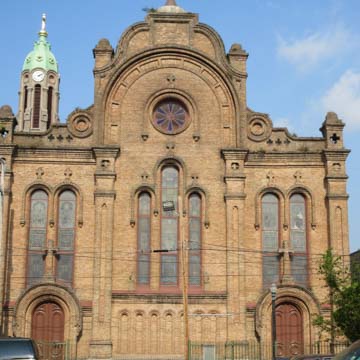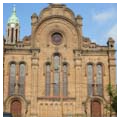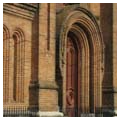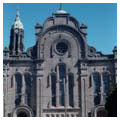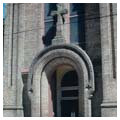It is said that St. Mary’s German parishioners helped in the church’s construction by wheeling carts of bricks from barges at the foot of Jackson Avenue. St. Mary’s facade is distinguished by its beautiful brickwork and rounded forms. Tall arched openings are deeply set in the wall and outlined with prominent moldings, above which are a small rose window and a curving parapet with circular blind windows. A 142-foot-high tower, located next to the sanctuary, changes from square to variously shaped octagonal stages as it rises, each transition defined by curved arches or brackets, finally tapering to a series of miniature gilded segmental domes. Side walls are reinforced with paired pilasters that continue above the roofline in the shape of miniature pedestals.
The equally florid interior has a ceiling with thick-ribbed vaults supported on fluted columns with overwrought floriated capitals. Foliate pendants are suspended from each of the arcade’s arches. The multilayered, intricately hand-carved wooden high altar was made in Germany in 1874. After the parishioners saw the spectacular stained glass windows at St. Alphonsus (OR130), in the 1890s they too commissioned F. X. Zettler, who made representations of favorite German saints and of Mary as Queen of Heaven. Following hurricane damage in 1965, the church was restored by Nolan, Norman and Nolan, and Koch and Wilson, Architects.
Along with the churches, the Redemptorists sponsored Catholic schools, convents, and orphanages to serve the neighborhood. The three-story building (1940) at 919 Josephine Street next to the church, originally a convent, is now the Seelos Welcome Center, named for Father Francis X. Seelos. The former girls’ grammar school (1867; now Seelos Hall) associated with St. Mary and St. Alphonsus churches stands at 2118–2122 Constance Street.


